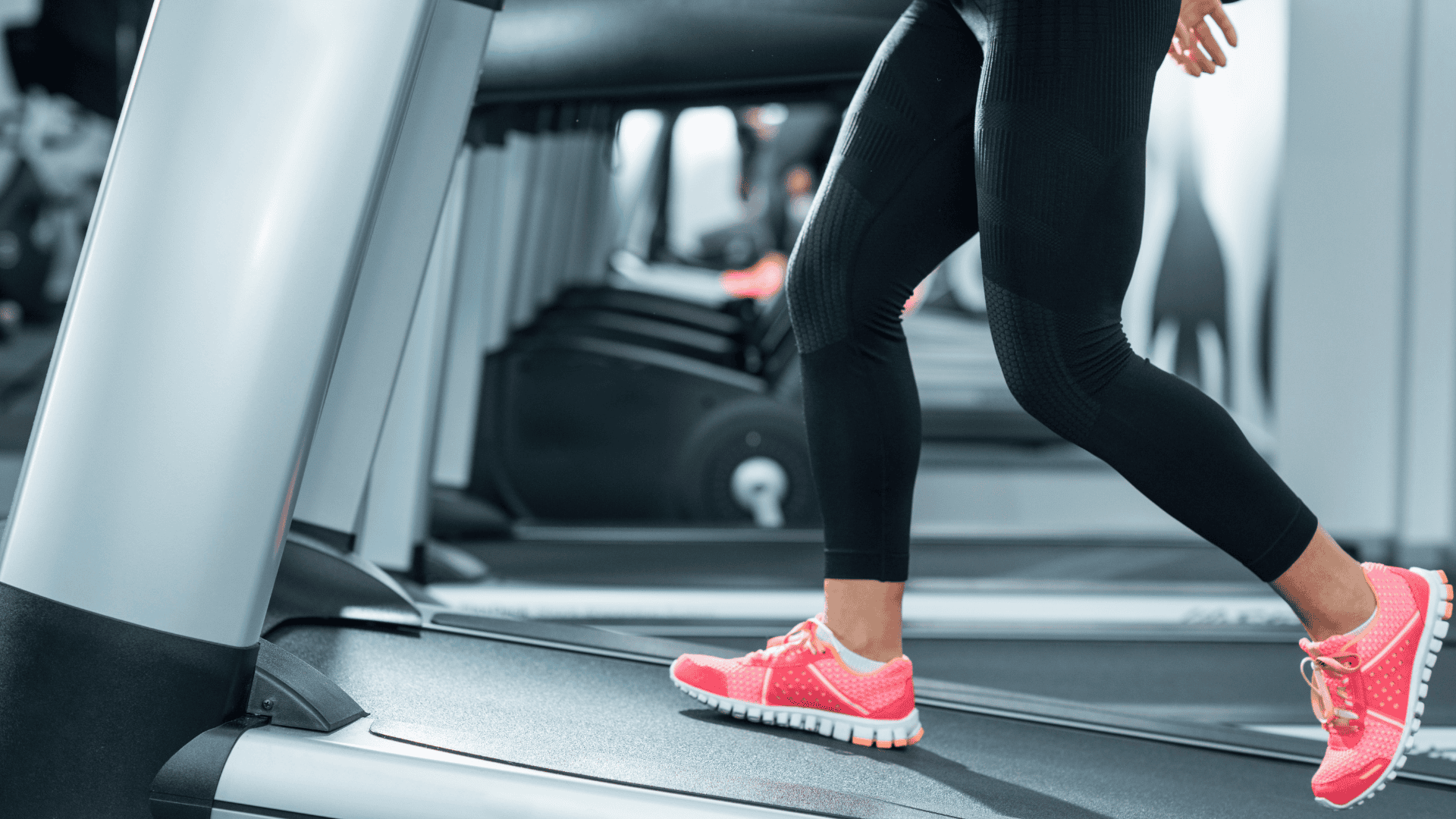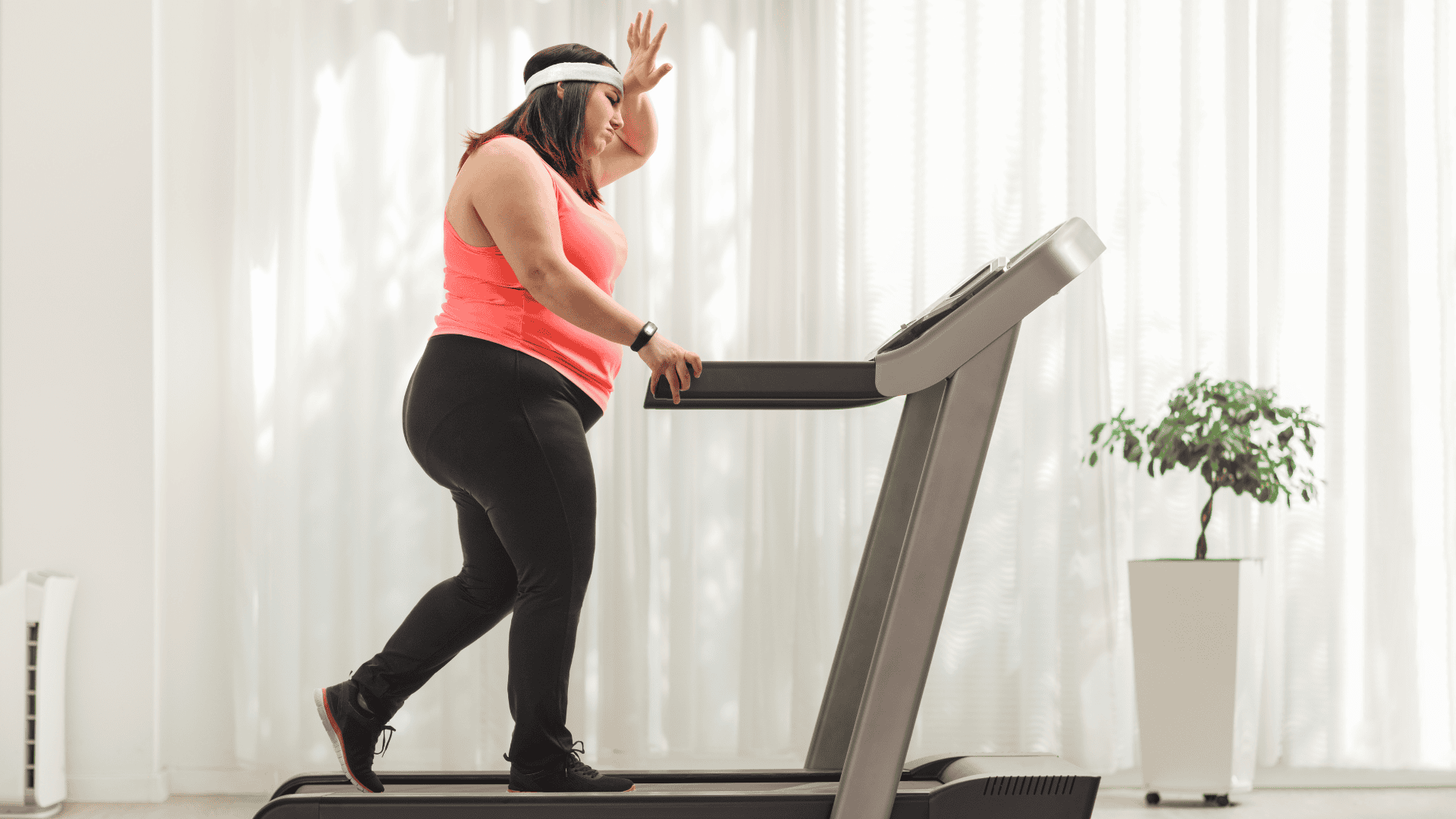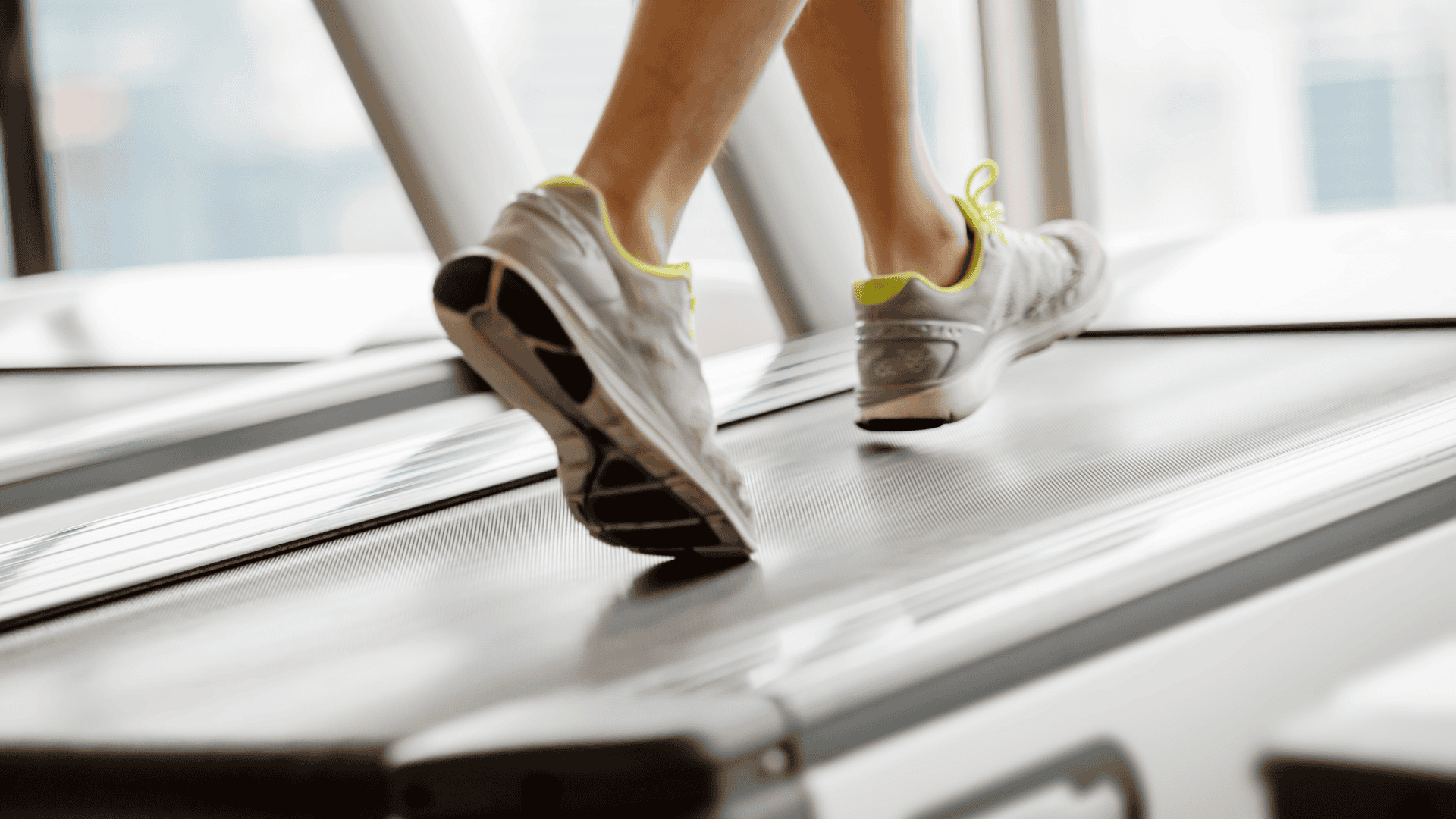Tired of walking on the treadmill and not seeing real results? You’re not alone.
A lot of people hit “start,” do the same slow pace, and wonder why nothing’s changing. The thing is, burning fat on the treadmill isn’t just about moving…
It’s about HOW you move.
When you use the right mix of timing, pace, and short bursts of effort, the treadmill becomes a powerful fat-burning tool. You don’t have to run or do anything crazy. Just a few small changes in how you walk can make a big difference.
This guide gives you 5 clear, beginner-friendly treadmill workouts built to help your body use fat for fuel. Whether you’re walking flat, adding incline, or doing both, these simple routines help you burn more in less time.
5 Fat-Burning Treadmill Workouts
There’s no one perfect speed or incline that burns fat for everyone. But there is one thing that works across the board: structure.
Below, you’ll find five treadmill workouts that help your body burn fat using intervals, steady effort, and smart pacing. You can pick whichever one fits your mood, time, or energy.
And the best part? You don’t need to run unless you want to.
1. Incline Walk Intervals

What it works: Your legs, glutes, core, and heart
Time: 20 to 30 minutes
How to do it:
- First, warm up with a flat walk for 3 to 5 minutes (aim for 3.0 to 3.5 mph).
- Then repeat:
- 1 minute walking on an incline (set it to 6 to 10%)
- 2 minutes walking flat (0 or 1%)
- 1 minute walking on an incline (set it to 6 to 10%)
Do this combo 6 to 8 times. After that, cool down with 3 to 5 minutes of flat walking.
Why it works: The incline pushes your heart rate up and targets your lower body without adding speed.
2. Walk-Jog Routine

What it works: Your heart, lungs, and full-body burn
Time: About 25 minutes
Here’s how to do it:
- Start with a 5-minute easy walk (2.5 to 3.5 mph).
- Then alternate between:
- 1 minute light jog (4.5 to 5.5 mph)
- 2 minutes walk (3.0 to 3.5 mph)
- 1 minute light jog (4.5 to 5.5 mph)
Repeat that cycle for 15 to 18 minutes, then cool down for 2 to 3 minutes.
Why it works: The short bursts of jogging boost your heart rate, and the walking gives you just enough rest to keep going.
3. Steady-State Power Walk

What it works: Long, steady fat burn with low stress on your joints
Time: 30 to 45 minutes
To get started:
- Warm up for 3 minutes.
- Then walk at a brisk, steady pace (3.5 to 4.0 mph) with a slight incline (1 to 2%).
Stick with that pace the whole time.
Why it works: This one’s all about keeping a steady burn. You’ll stay in the fat-burning zone without wearing yourself out.
(Pro tip: This is a great time to zone out with your favorite playlist or podcast.)
4. Ladder Intervals

What it works: Heart rate control and slow, steady fat burn
Time: 20 to 25 minutes
Here’s what to do:
- Begin with a 5-minute warm-up walk.
- Then:
- Start flat
- Every minute, increase incline or speed
- After 5 minutes, reverse it by lowering one level per minute
- Start flat
If you’re up for it, do two full ladders. Then walk for 3 minutes to cool down.
Why it works: You slowly work your way up and back down — no burnout, just a solid push.
5. Short Burn Circuit (Under 20 Minutes)

What it works: Fat burn when time is tight
Time: 15 to 18 minutes
To make it happen:
- Warm up for 2 to 3 minutes with a light walk.
- Then try this mix:
- 2 minutes incline walk (6%)
- 1 minute fast walk (4.0 to 4.2 mph)
- 1 minute incline walk (8%)
- 1 minute walk
- 1 minute jog (optional if you’re feeling up for it)
- 2 minutes incline walk (6%)
Repeat the whole thing twice. Then cool down with a slow 2-minute walk.
Why it works: The combo of pace changes keeps your body guessing, and the short time makes it easy to squeeze in.
How the Treadmill Helps You Burn Fat
A treadmill isn’t just for walking. It’s a tool that helps you move with purpose and stay in control of how hard you work.
When you keep a steady pace for more than a few minutes, your body starts using stored fat for energy instead of just carbs. That’s why longer walks or light jogs can be great for fat loss.
They give your body enough time to shift gears and start burning fat.
Adding intervals makes it even more effective. Small changes in speed or incline can raise your heart rate, boost your effort, and help you burn more calories in less time. The goal isn’t to sprint. It’s to keep your body working just hard enough to stay in the fat-burning zone.
The treadmill makes this simple. You can adjust the speed, the incline, and how long you go, all with a few buttons. This helps you build different workouts that match your energy, your fitness level, and your goals. You can start with a slow walk and work your way up.
Treadmill workouts really do help with fat loss. You just need a little structure, a plan that’s easy to follow, and the patience to stick with it.
How to Know You’re in the Fat-Burning Zone

You don’t have to sprint or be dripping sweat to burn fat. What really matters is how long you move and how hard it feels. (not how fast the treadmill number climbs)
Your goal is a steady pace that feels a little challenging but still doable. A simple way to tell? You can talk, but you wouldn’t want to have a full-on conversation. That sweet spot means your body is working just hard enough to tap into fat for fuel.
If you’re walking, this usually means a quick pace that feels more like “I’m on a mission” and less like a casual stroll. If you’re using incline, your legs might feel the burn a bit, but your breathing should still be steady.
Here’s a quick cheat sheet:
- Too easy: You’re texting, scrolling, or planning dinner. Your body’s barely working.
- Just right: You can say a sentence or two, but you’re focused. Breathing is deeper, but you’re not gasping.
- Too hard: You’re huffing and puffing, and it’s tough to keep going. This burns carbs, not fat.
You can also use a heart rate monitor if you want. Fat burn usually happens around 60 to 70% of your max heart rate. But honestly, you don’t need tech to figure it out.
Just pay attention to how you feel.
Keep it steady. Stay a little challenged. And give it enough time. That’s how your body learns to burn fat better.
Weekly Schedule to Stay Consistent
To burn fat and actually stick with it, you don’t need to work out every single day. What you do need is a steady, repeatable plan that mixes effort with recovery, so your body has time to respond, and your mind doesn’t burn out.
The sample schedule below uses the 5 workouts from earlier. It spreads them out over 4 days a week, giving you both variety and rest.
You can adjust the days to fit your routine, but the structure stays the same: a mix of longer walks, intervals, and lower-intensity recovery.
Here’s how it can look:
| Day | Workout | What It Does |
| Monday | Incline Walk Intervals | Burn fat + build glute and leg strength |
| Tuesday | Rest or Light Walk | Recovery and muscle repair |
| Wednesday | Walk-Jog Routine | Boost heart rate and endurance |
| Thursday | Rest or Mobility Stretching | Helps with soreness and movement quality |
| Friday | Steady-State Power Walk | Long, low-stress fat-burning session |
| Saturday | Short Burn Circuit | Quick, high-effort workout in less time |
| Sunday | Optional Walk or Full Rest | Listen to your energy—recover if needed |
A Few Tips:
- You can swap days based on your schedule, just try to keep at least one full rest day.
- If you’re just starting, begin with 2–3 days/week, then build up over time.
- Don’t skip the warm-up or cool-down; they keep you consistent and injury-free.
Staying consistent doesn’t mean doing more. It means showing up regularly with a plan you can actually follow. That’s what makes fat loss sustainable.
What to Do Before and After Your Treadmill Session
Warming up and cooling down might sound skippable, but they’re low-key the secret to keeping your body happy and your progress on track.
Before your workout, spend 3 to 5 minutes getting your body ready. It doesn’t need to be fancy. Start with 10 ankle rolls in each direction (yes, those little circles matter). Then do a few hip circles to loosen things up. After that, hop on the treadmill for a slow walk. This helps your joints warm up and gets your muscles ready to move.
You’ll feel more steady and walk smoothly once everything’s warmed up.
After your workout, don’t hit stop and head straight for the door (tempting, we know). Walk at a slower pace for 2 to 3 minutes to bring your heart rate down. Then take a few minutes to stretch your calves, hamstrings, and hip flexors.
These spots usually get tight, especially after incline work. Hold each stretch for about 20 to 30 seconds on each side. (Nothing wild, just enough to help your body relax)
Doing these quick steps before and after each session can help you feel less sore, move better, and come back ready to go next time.
What Fat-Burning Progress Really Looks Like
When you’re trying to lose fat, it’s easy to focus only on the scale. But here’s the truth: the scale doesn’t tell the whole story.
Real progress usually shows up in smaller ways first. Maybe you’re not breathing as hard during your walks. Maybe those incline intervals don’t feel like they’re out to ruin you (we’ve all been there).
That means your body’s getting stronger.
Your clothes might start to feel a little better too, even if the number on the scale stays the same. That’s because you’re building lean muscle while burning fat, which helps shape your body in all the right ways.
Another big sign? Energy. If you’re feeling less tired during the day or more focused after your workouts, that’s your body saying “hey, this is working.”
Progress can be quiet. It shows up in how steady your pace feels, how your legs recover, and how your posture looks in the mirror.
So even if it’s not dramatic yet, it’s happening.
Keep showing up. Keep doing the work.
Your body is making changes, even if the scale hasn’t caught up yet.
Frequently Asked Questions
1. How many minutes should I walk to burn fat?
Aim for 20 to 45 minutes per session. Fat-burning typically kicks in after the first 15–20 minutes of steady effort. That’s why structured workouts with intervals or incline can help you get there faster and stay there longer, even if you’re just walking.
2. Do I need to run on the treadmill to lose fat?
No, you don’t need to run. Walking with purpose, especially with incline or timed intervals, can be just as effective. Running adds intensity, but fat-burning depends more on how consistent and structured your workouts are than how fast you go.
3. What incline is best for fat burning?
Start with an incline of 4–6% for a solid fat-burning zone. If that feels easy, you can go up to 8–10% in short bursts. The incline raises your heart rate without needing speed, which helps your body use fat for fuel while building lower-body strength.
4. Can I do this daily, or should I rest?
You can walk every day, but for fat-burning treadmill workouts (especially intervals), 3 to 5 days a week is ideal. Mix in light walks or recovery days in between so your body has time to reset and adapt. Overdoing it too soon can backfire.
5. What should I eat before and after a treadmill workout?
Before your workout, keep it light, like a banana, piece of toast, or small handful of nuts, especially if you’re working out in the morning. Afterward, aim for protein and carbs within an hour. Think: eggs and toast, a smoothie, or yogurt with fruit. This helps your body refuel and recover without undoing your progress.










